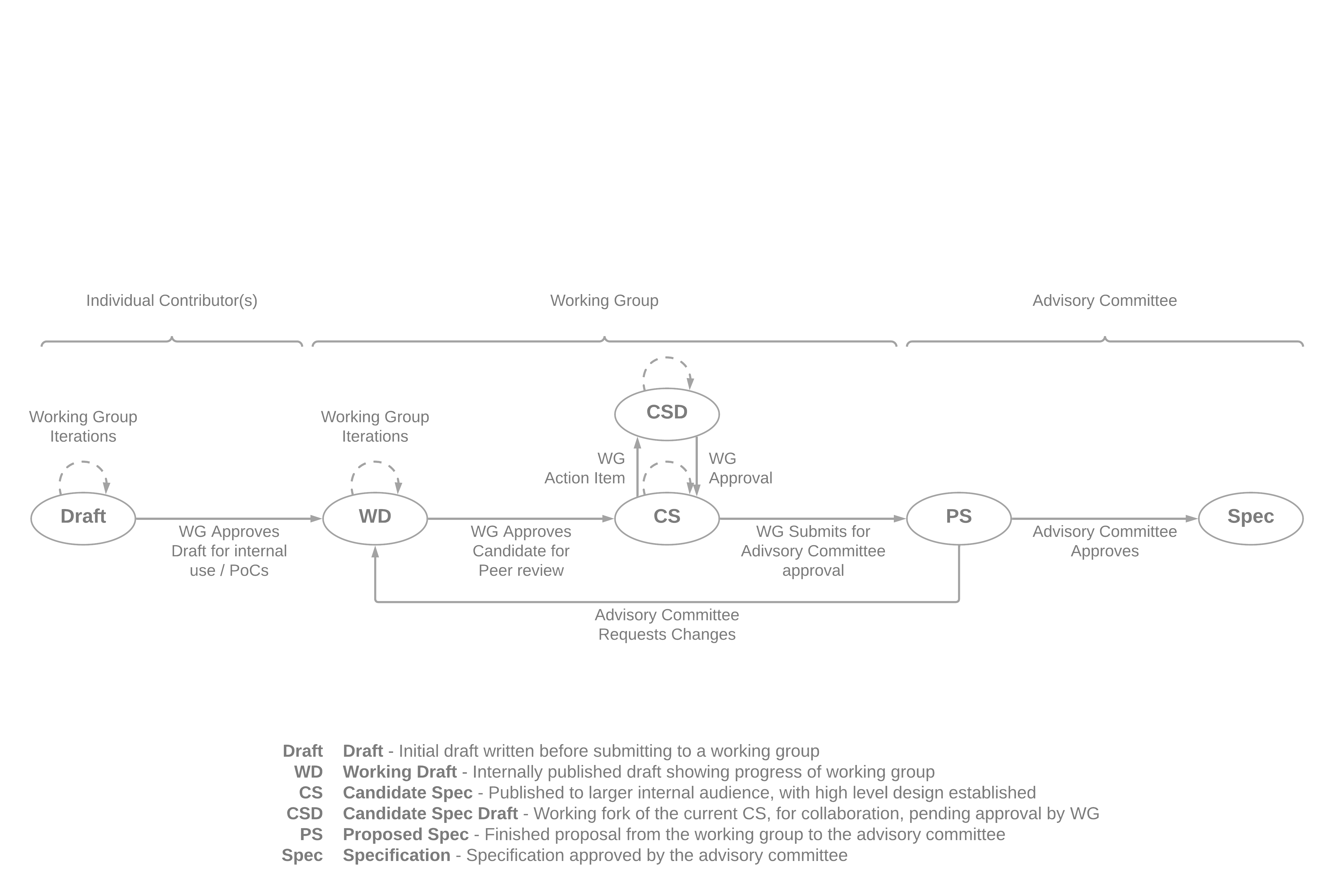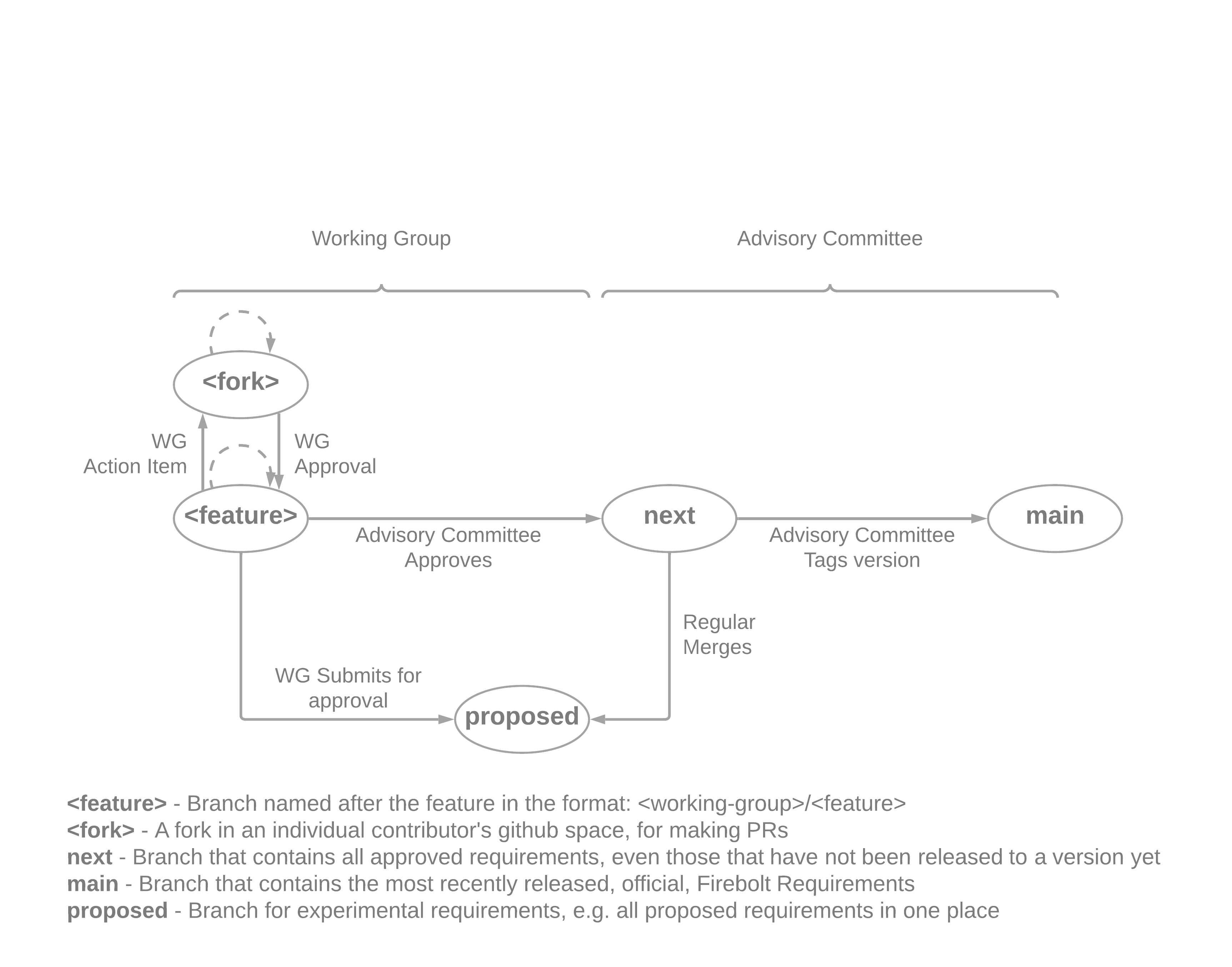Requirements Governance
This document outlines the governance model for the Firebolt® Open-Source Project, including the structure of an Advisory Board and Working Groups, as well as the process used to codify Requirements Specifications and Architectural Decision Records.
1. Overview
The Firebolt Open-Source Project is governed by an Advisory Board that creates and delegates work to Working Groups, which then create proposals for Requirements Specifications and Architectural Decision Records.

2. Table of Contents
- 1. Overview
- 2. Table of Contents
- 3. Goals
- 4. Governance
- 4.1. Scope
- 4.2. Firebolt Version
- 4.3. Advisory Board
- 4.4. Advisory Board Members
- 4.5. Working Group
- 4.6. Requirements Specification
- 4.7. Architectural Decision Record
- 4.8. Approval Stages
- 4.9. Requirements Repository
- 4.10. Requirements Repository Branching
- 4.11. Sanctioned Forks
- 4.12. Release Versions
3. Goals
The goal of the Firebolt Open-Source Project is to provide a Distributor-configurable set of integration APIs and functional requirements for those APIs so that Apps can integrate with the APIs once and run their app on every Firebolt platform (regardless of distributor) consistently.
Specifically, Firebolt provides:
- Write Apps once, run on all Firebolt distributors
- Discovery and launching of Apps
- Detection of, and access control for, Firebolt APIs and features
- Discovery of app content and metrics once discovered
- Platform integration APIs, (e.g. captions, media info, etc.)
- Device and account management
- Integration APIs for broader eco-system integrations (e.g. user experience, advertising, voice, etc.)
While enabling Distributors to:
- Provide differentiating Discovery and Settings experiences
- Configure Firebolt features to meet their business needs
- Configure Firebolt user privacy & opt-in settings
- Decide which set of optional Firebolt features to support
- Negotiate access to features and APIs with each app
4. Governance
The Firebolt Open-Source Project is governed by an Advisory Board. The purpose of the Advisory Board is to ensure that each major, minor, and patch version of the Firebolt Requirements is aligned with the goals of the Firebolt Open-Source Project.
The Firebolt Requirements are the collection of all Requirements Specifications and all Architectural Decision Records that are ratified by the Advisory Board (and contained in this repository).
4.1. Scope
This document describes the governance model for the following components:
- Firebolt RPC APIs & SDKs
- Firebolt Media Pipeline (aka Rialto)
- Firebolt API Reference Implementation (Ripple)
4.2. Firebolt Version
A Firebolt Version is a snapshot of the Firebolt Requirements that has been ratified as an official release of the requirements. Note that the requirements are decoupled from any implementation of those requirements, and iterations to the requirements will occur with input from any teams implementing them.
Firebolt Versions MUST follow Semantic Versioning.
4.3. Advisory Board
The Advisory Board oversees all aspects of Firebolt Requirements Governance.
Advisory Board decisions should aim to be unanimous whenever possible, but in cases of deadlock, may be decided by simple majority.
The Advisory Board is responsible for:
- Prioritization of Working Groups needed
- Creation of balanced Working Groups with relevant subject matter experts
- Solicitation of peer review by SMEs that are not from the working group
- Ratification of requirements into the official Firebolt Requirements
- Determination of when to tag a new minor version release of the Firebolt Requirements
- Determination of when to tag a new major version release of the Firebolt Requirements
- Determination of when a sanctioned fork is warranted
4.4. Advisory Board Members
The Firebolt Advisory Board is currently being formed and will be published soon.
Contact the rdkcentral/firebolt-apis maintainer, Jeremy LaCivita, to submit proposals to the Advisory Board.
4.5. Working Group
Working Groups build consensus on requirements for Firebolt features or architectural solutions. They should ideally be three to five individuals spanning technical and product experts. Further recommendations on working group composition are left to the Advisory Board.
As new features are prioritized, Working Groups should be formed to gather and document requirements for those features. Working groups may be self-forming or selected by the Advisory Board, but all working groups must have their membership reviewed and approved by the board to ensure that they are well balanced.
The Advisory Board MAY appoint a Working Group Chair or instruct the Working Group to select a chair amongst themselves.
The Working Group Chair is responsible for driving consensus and reporting back to the Advisory Board
4.6. Requirements Specification
A Requirements Specification includes all details necessary for multiple, disassociated teams to build a consistent implementation of a feature, including API signatures, validation, and functionality, as well as functional and behavioral requirements of the feature that are not directly exposed by an API.
Requirements and APIs may be targeted towards traditional 3rd party apps, as well as more foundational 1st party apps.
The level of detail in an acceptable Requirements Specification should be such that any App should run consistently on any implementation of the feature that is based on the Specification.
Requirements Specifications are written using the IETF Best Common Practice 14 and should include the following at the end of the Overview:
The key words “MUST”, “MUST NOT”, “REQUIRED”, “SHALL”, “SHALL NOT”, “SHOULD”, “SHOULD NOT”, “RECOMMENDED”, “NOT RECOMMENDED”, “MAY”, and “OPTIONAL” in this document are to be interpreted as described in BCP 14 [RFC2119] [RFC8174] when, and only when, they appear in all capitals, as shown here.
Requirements Specification move through several stages from being a draft, to being an official versioned requirements specification.
4.7. Architectural Decision Record
An Architectural Decision Record includes all details necessary to ensure that Firebolt Requirements are fulfilled with an architecturally sound design. This is often used in cases where listing out explicit requirements, e.g. performance or operational requirements, is not possible or realistic, e.g. Requiring use of a well-known open source component to fulfill some aspect of the platform, or requiring adherence to a high level modular breakdown of concerns to keep platform maintenance manageable.
Since ADRs included in the Firebolt Requirements MUST be adhered to, not every architectural decision made in order to fulfill the Firebolt Requirements needs to have a formal ADR in the Firebolt Requirements repository. It is up to the Advisory Board which ADRs warrent a formal inclusion in the Firebolt Requirements.
ADRs move through the same stages as Requirements Specifications.
4.8. Approval Stages
Requirements specifications and ADRs are written by working groups and go through several stages of approval before becoming official requirements documents.

4.8.1. Draft
This is any first draft of a requirements specification submitted by an individual or individuals to a Working Group.
Artifacts:
- A markdown document, ready to be presented to the Working Group
Note that a Draft MUST not be committed to any public location, e.g. the Requirements Repository, because it has not yet been reviewed by the Working Group and could mistakenly contain sensative, private information related to a specific Firebolt distributor.
4.8.2. Working Draft
A version of the requirements specification that is approved by the Working Group for feedback and review by individuals not on the Working Group. Individuals are selected for review at the discretion of the Working Group. Working drafts may or may not satisfy all requirements of the feature and should not be used for derivative works.
Artifacts:
- Markdown specification in a named feature branch of the Requirements Repository
- Working Group members identified
- Working Group progress is being tracked via GitHub project in the Requirements Repository
4.8.3. Candidate Specification
A version of the requirements specification that is approved by the Working Group for proof-of-concept implementations and peer-review by the larger Community. Candidate Specifications have been through significant review by the Working Group and are ready for feedback from the larger community.
Once this is published to the peer group for review, they’ll have two weeks to add their comments, make amendments requests, etc.
Artifacts:
- Markdown specification in a named feature branch of the Requirements Repository
- Domain experts for peer-review identified and notified
- Repeat process for any C.S. Drafts that are formalized into the C.S. (see below)
- JSON-Schema API changes outlined by the document are in the OpenRPC schemas
4.8.4. Candidate Specification Draft
A fork of the current Candidate Specification that has changes requested, but not yet approved, by the Working Group.
Artifacts:
- A Pull Request into the feature branch containing in-progress changes
- Previous Candidate Specification does not include changes until approved by W.G.
4.8.5. Proposed Specification
A version of the requirements specification that is considered, by the Working Group, to be the final Candidate Specification, and has been submitted to the Advisory Board for final approval. This version may be used for experimental implementations and final peer-review by the larger community.
Artifacts:
- Markdown specification merged into the #proposed branch of the Requirements Repository
- A Pull Request into the #next branch of Requirements Repository
- JSON-Schema API changes outlined by the document are in the OpenRPC schemas
- Unit tests for any API changes
4.8.6. Specification
An official versioned stage of the requirements specification that is done and will not change until a future version is created. This version may be used for official production implementations.
Artifacts:
- Markdown specification merged into the #main branch of the Requirements Repository
- Spec Review notes and green light from implementation teams of all member organizations with a vested interest in the specification
- Status tracking link for any Open Source implementations of the spec, if appropriate
4.9. Requirements Repository
A public GitHub repository used to manage the progress of a requirements specification. Requirements Specification MUST live in their own repository, and not along side of the code that is implementing them.
The Requirements Repository MUST be located at:
https://github.com/rdkcentral/firebolt-apis
4.10. Requirements Repository Branching
The Requirements Repository MUST have the following branches:
| Branch | Purpose |
|---|---|
| main | For officially approved specifications that have been released under a version. |
| next | For all approved specifications, even those that have not been released under a version. |
| proposed | An experimental branch containing all proposed specifications. |
Working Drafts and Candidate Specification Drafts MUST be housed in a named feature branch in the Requirements Repository (see below).
Branches are merged based on the approval process:

4.11. Sanctioned Forks
From time to time an organization with access to the Requirements Repository may want to spearhead a new feature without going through the formal approval process.
In this case the member may submit a request to the Approval Board for a sanctioned fork inside the Requirements Repository, so that research and development can be done on the feature.
The Approval Board MAY grant or deny the request for a sanctioned fork.
After the R&D is complete, the forking organization MUST submit the resulting requirements to the formal process and work to have them approved.
The organization requesting the fork MUST be willing to migrate to the approved APIs, which may be different than the API in the fork.
The Advisory Board, and selected Working Group, SHOULD be willing to avoid unnecessary changes to make migration as easy as possible, without sacrificing the integrity of the Firebolt Open-Source Project’s goals.
4.12. Release Versions
The Advisory Board has ownership of when to do major, minor, and patch releases of the Firebolt Requirements.
Releases MUST follow Semantic Versioning.
Approved changes are all housed in the next branch until the Advisory Board decides that the next branch warrants an officially released version of the requirements.
If a feature that requires a major version increment, i.e. a breaking change, is proposed, the Advisory Board may decide to keep it unapproved so that any features requiring a minor version change can be pushed through the process. Management of this is the responsibility of the Advisory Board.
 Firebolt Documentation
Firebolt Documentation